A Portable Setup for Narrowband Astrophotography:
Zeiss 135mm, CCD camera, Avalon M-Zero, Gitzo GT5532s
The first three inches are the most important
In the bad old days, ambitious astrophotographers had to accept the risk of a slipped disk in order to make serious work under the stars. Corpulent flat-field scopes, noisy large format cameras, heavy mounts, car batteries, computer stuff and cable salad spiced with unfailing patience were in the menu when an astrophotographer decided to meet the competition at eye level. As time goes by, the wish to abandon the mass while keeping the class comes up.
This is a description of a fast telephoto setup for narrowband astrophotography. It consists of an ICX814-based CCD camera, a Carl Zeiss Sonnar 135mm (f/2) APO lens, a guiding subsystem, an Astroholgi MicroFocuser (AH-MF), an Avalon Zero mount and a Gitzo GT5532s tripod. Seemly invisible customized parts are placed at key positions to make those standard products work together as one system. This portable configuration offers a wide 6x5° field-of-view (FOV) and a useful resolution of 5.6".
This setup was thought up by three amateur astrophotographers. Holger Weber, Markus Noller and me had endless discussions over months how a portable astrophotographic setup should look like. Holger had the most practical answers. Markus inspired us with the smartest ideas. I had the most expensive solutions in mind. In some way, we were the perfect team for designing it.
The Classic Way
A widely used setup for astrophotography has often consisted of the legendary KAI-11000 sensor, a fast 106mm quadruplet scope, a 30kg class mount plus an adequate tripod. It has had the ability to match the common seeing conditions in Europe/ North America.
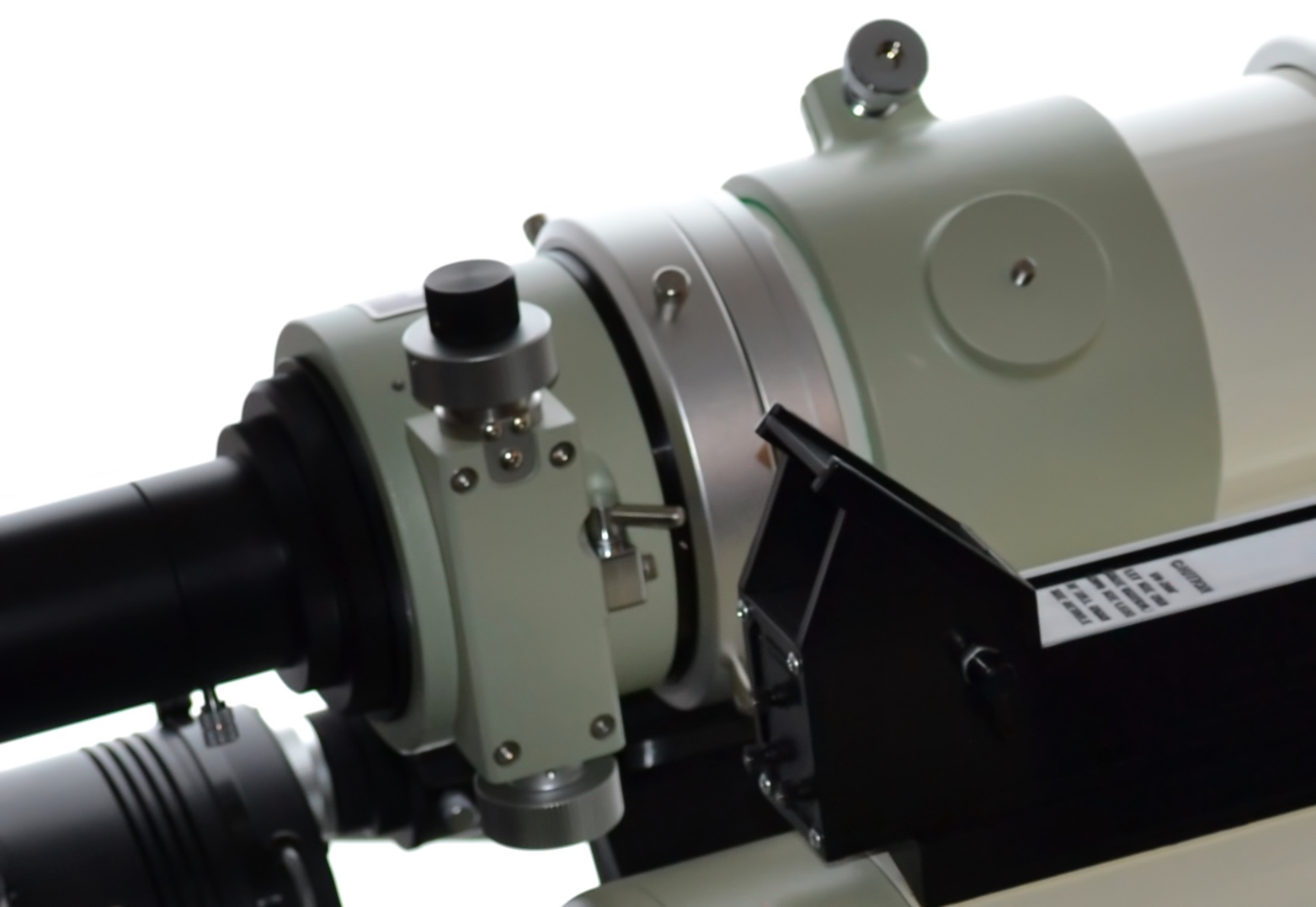
Quadruplet 106mm & KAI-11000 camera
Scope: 10.6cm aperture, 8 lenses (scope+reducer), 385mm, f/3.65
Critical Focus Zone (CFZ): 29,15μm
Camera: hosting a KAI-11000 sensor
FOV: 5° 21' 24'' x 3° 34' 16''
Resolution: 4.8"
FWC: 60000e-
Sensitivity at Hα line: 30%
Typical read noise: 11 e-
Dynamics: 9.4 mag, 5455 grayscale values
Pixel array: 11 MPixels
Focuser: integrated
Mount: 30kg class GoTo mount
Tripod: Wooden or metal tripod for 60kg load
Let's consider the system weight. The mount weights 16 kg, telescope is 8kg, counter weights 16 kg, tripod 8kg, camera incl. filter wheel 5 kg, plus the ... carrying cases.
The Future is now
The future is smart, light and flexible. We can already see how iPhones, iPads and Co. are changing our world. Our perception of a useful computer has been radically changed in the last decade. We replaced our old desktops with tablets. We drive to work with e-cars instead of using diesel trucks. We start wearing smart watches instead of mechanical chronometers. Has the time come to fundamentally re-think our telescope setups?
The game changer
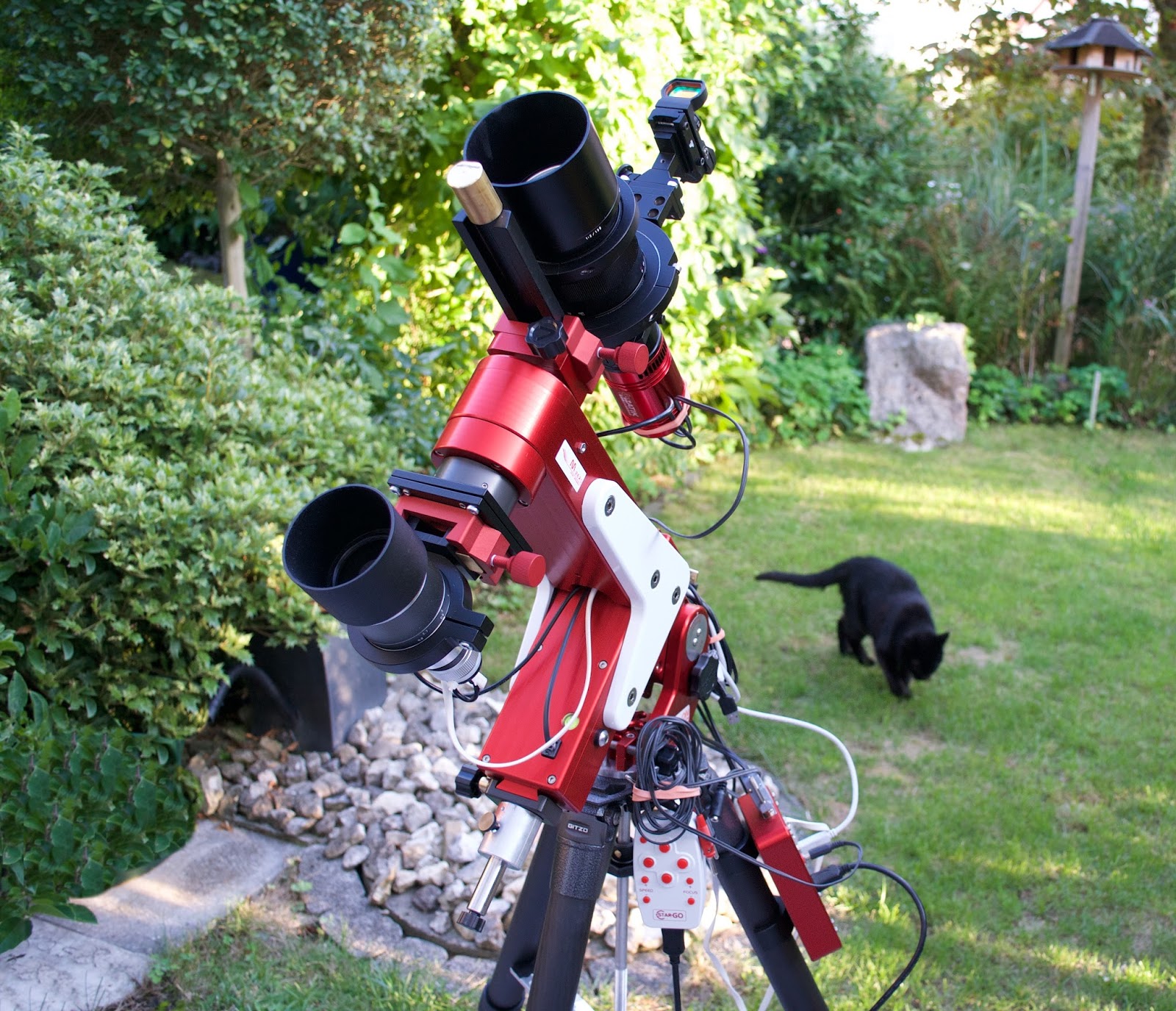
Could a modern, light setup rival fat systems of the past? In certain cases, when uncompromising power plays a key role, nothing can defy the laws of physics. But if portability comes at first place, the answer might be somehow interesting or even ground-breaking.
Zeiss Sonnar 135 & ICX814-based CCD
Scope: 6.6cm aperture, 11 lenses, 135mm, f/2
Critical Focus Zone (CFZ): 8,8μm
Camera: ICX814-based CCD
FOV: 5° 17' 36'' x 4° 14' 5''
Resolution: 5.6"
FWC: 18000e-
Sensitivity at Hα line: 65%
Typical read noise: 5 e-
Dynamics: 8.7 mag, 3600 grayscale values
Pixel array: 9 MPixels
Focuser: Astroholgi
Mount: Avalon Zero GoTo mount
Tripod: Gitzo GT5532s
May the Force be with you!
Look at the specs once again and you will know, what I am thinking about. It's not that much difference in terms of performance, isn't it? I mean, in the first case you have to carry some 60kg around. It's not the scope alone. You have to carry the mount, the heavier CCD including its pizza-like filter wheel, more counter weights, and a beefy tripod. Should there be any money left, you are well advised then to look for a fitness studio. You will need the force to carry the stuff around.
Finally, the question remains if a big system can exhaust its potential under the usual seeing conditions (Europe: 3..4") in your location. Is it reasonable to invest on such a big one under these circumstances?
A tiny world full of details
A Setup from Hell
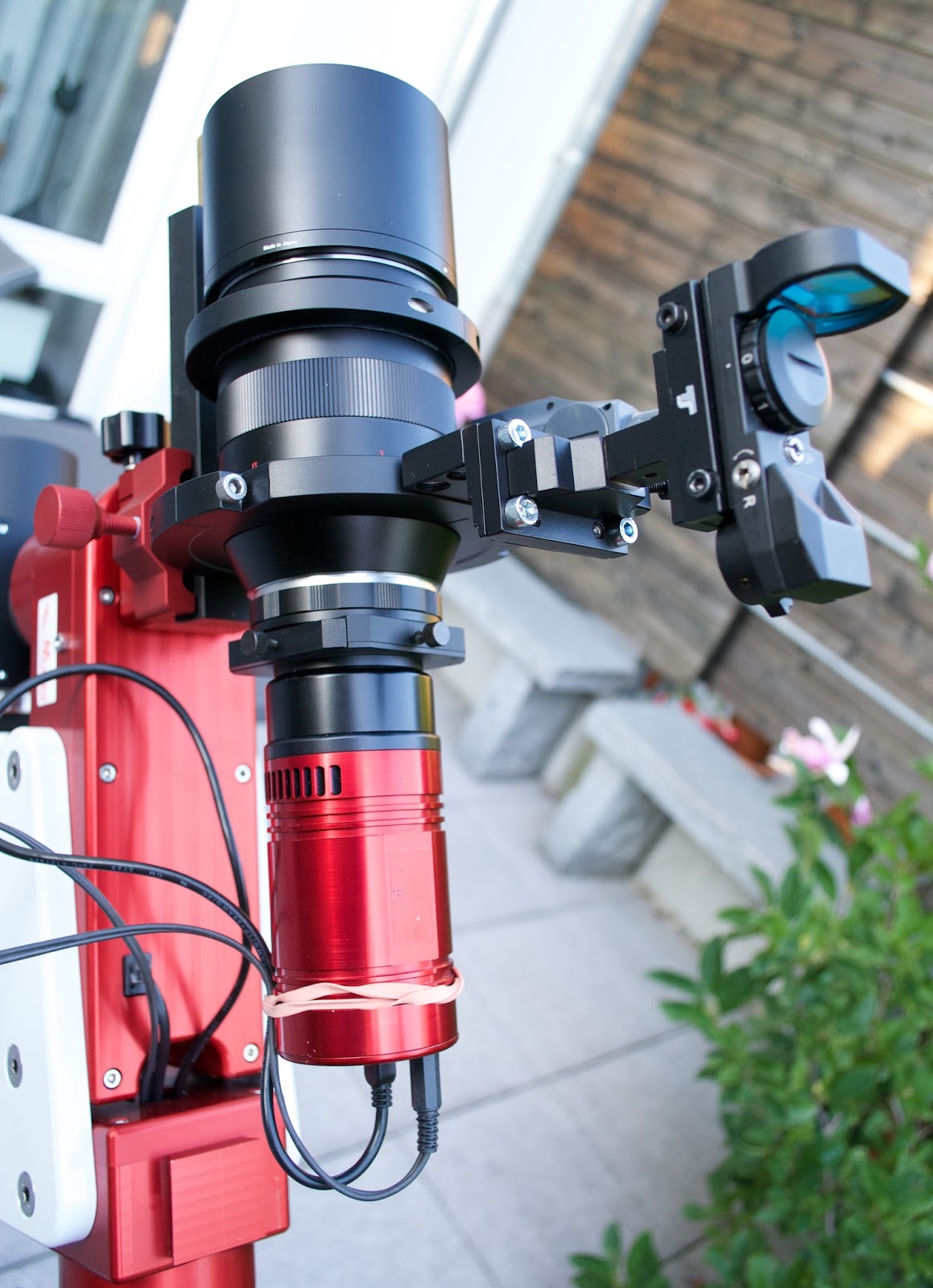
The main challenge during the system design phase was to master the miniaturization. Unlike bigger setups, where you deal with issues such "large" and "heavy", you confront with challenges like "as small as possible" or "so light as its gets".
During designing a focussing subsystem you continuously fight in a mini world full of details. Astroholgi has already won this fight for you. The highlight of the story: The Astroholgi Telephoto Lens MicroFocuser forms a camera independent system. In contrary to conventional solutions , where the camera body, the focuser and the lens constitute a integral/monolithic system, the Astroholgi Microfocuser transforms the Zeiss lens to a sort of telescope, better said astrograph.
In addition to common DSLR bodies, high performance astronomy cameras can be mounted on the Zeiss lens, if they have short enough backfocus. In our setup, the ICX814-based CCD we used has 13mm backfocus. You can use the Zeiss Sonnar ZF.2 lens variant for Nikon instead of the ZE for Canon to gain 2mm more metal back distance (46.5mm Nikon vs. 44mm Canon -> Nikon ZF.2 wins). The ZF.2 provides you also the possibility to manually set the f-stops without needing a camera body to electronically adjust it.
An easy way to make good RGB work is to simply attach a Nikon d810a DSLR on the lens. It offers a large 35.9 × 24 mm full frame FX format CMOS sensor, small 4.88 µm pixels, special optimized filter for astrophotography and useful software functions. Even so, you are well advised to use the Astroholgi MicroFocuser mentioned above.
Since narrowband astrophotography -a domain of monochromatic cameras- was our objective, we have chosen a low-weight, ICX814-based CCD camera to catch the photons. Since, a focal length of 135mm ist short enough, the ICX814 sensor with its tiny but ultra-sensitive pixels is a good match even its sensor is not the biggest in the astrophotography scene.
Taming a Wild Horse
You might noticed Sonnar's tight CFZ of 8.8μm resulting from its ultra-fast focal ratio. You know, we are talking here about a focus zone of 9 thousandths of a millimeter! Like riding a Mustang is a no-go for novice riders, so astrophotography with this Zeiss killer lens is not recommended for greenhorns. It will kill all your images without an exception, if you can not tame it. But if you are looking for a wild workhorse, that can make you win a photography contest, you've just found it.
Can you ride it?
Apochromatic f/2 Lens
You might guess, it is a german artwork consisting of black metal with a lot of glass and two little pieces of plastic. The plastic parts are the caps :-) The Zeiss lens comes with a metal hood. The ZE version with EF mount for Canon is mainly considered in this report. It must be stated, that the Nikon ZF.2 variant offers the advantage of setting the aperture manually without the need of a DSLR body. This is something I really miss on the Canon ZE variant.

Apo Sonnar T* 2/135 Canon ZE version
Number of elements/groups 11/8
Weight=930 g
Filter thread M77 x 0,75
Dimensions (with caps) ZE: 130 mm
Aperture range f/2 – f/22
The Sonnar APO is perfect for astrophotography and it wonderfully lets the red Hα light to reach the camera sensor. Due to its apochromatic capabilities it is suitable for both RGB and narrowband work, i.e. for both color and monochrome cameras. A Nikon D810a, or an astro-modified Nikon DSLR are suitable candidates for RGB work. In that case, it is reasonable to use an IDAS LPS D1 77mm filter screwed in front of the lens in order to absorb the light pollution in your location. You can make twice longer exposures then. The IDAS Filter is approx. 1mm thin. If you already own the smaller 2" Hutech IDAS P2 filter, you can mount it on the Zeiss lens as well. Use the Geoptik adapter ring for 2" filters to M58 objective filter thread screwed on the XCSOURCE Step Up/Down Ring Filter Adapters. In that case, you deal with a smaller aperture of 50.8mm and f/2.6. Although aperture always counts -especially in astrophotography-, stopping down a lens might not be always a drawback. We achieved the most perfect star shape at f/3.5 across the field with this lens.
Thermal stability is crucial
Heater Bands
As usual, you need to acclimatize the lens before using it in the field. During the german winter, an hour is usually enough to cool down the Zeiss lens. To avoid fogging of the optics, especially at humid nights, heater-bands like those offered by Kendrick are recommended. The full metal construction of the Zeiss lens evenly conducts the heat from the barrel to the lenses. The heater-bands stabilize in some way the temperature in the lens and significantly reduce the need for refocussing during the night. This is one more reason not to undersize the power supply (see below).
Your eyes to the stars
CCD Camera
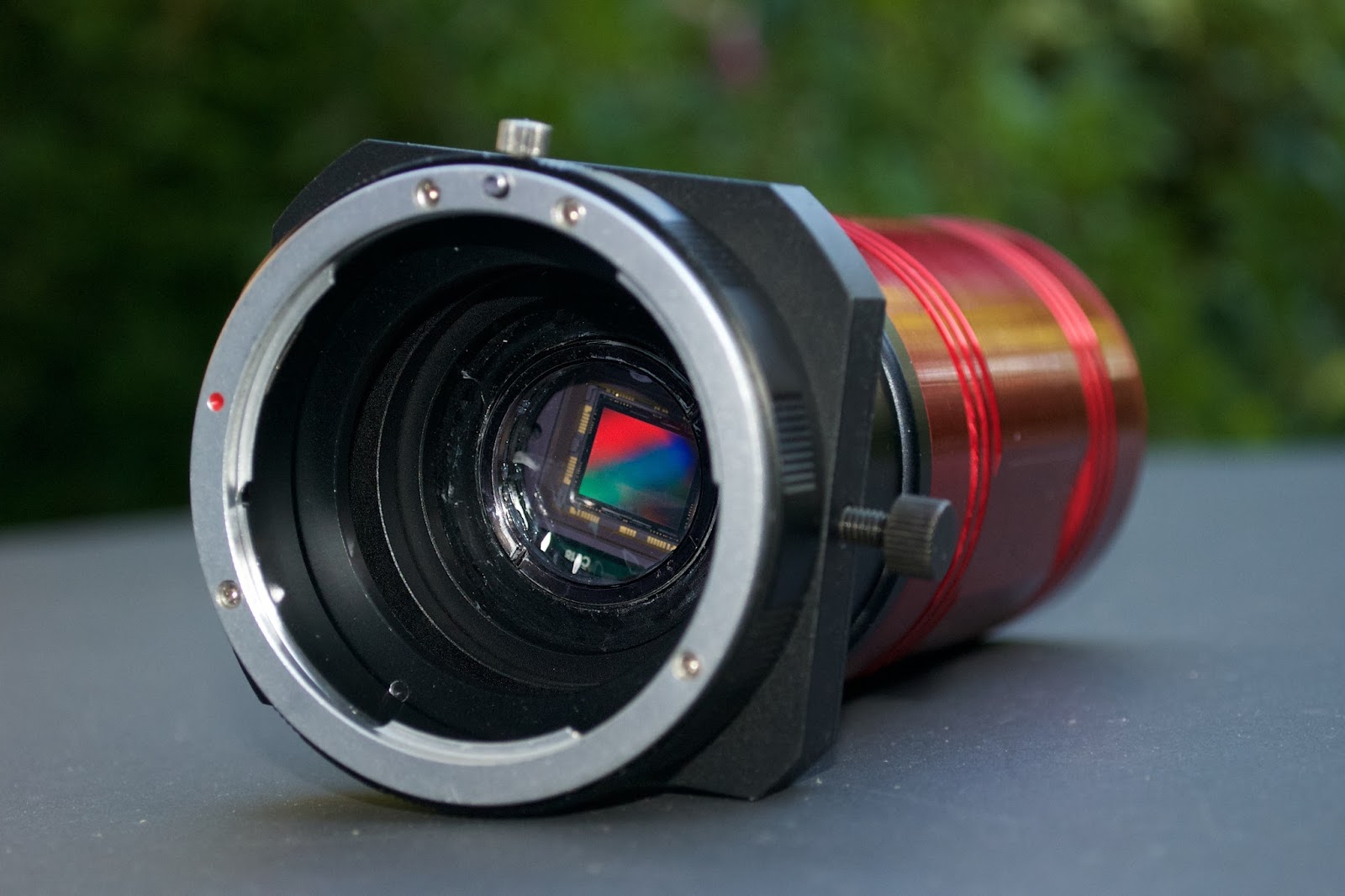
We have had solid arguments to choose an ICX814-based CCD as our main recording camera:
monochrome sensor that is best suited for narrowband work.
short metal back distance (13mm).
simple, comprehensible design.
over 65% response at Hα line.
regulated cooling system.
low weight.
high resolution resulted from its small 3.69μm pixels making it a good match for short focal lengths.
acceptable 18000e- Full Well Capacity (FWC) and a low read noise of 5e- contributing to dynamic images.
no CCD chamber with Argon, i.e. 2mm less glass in the optical path.
supplied with stable, field-proven control software.
Several manufacturers like QSI, SBIG, ZWO, QHYCCD, or SXCCD produce excellent cameras based on this powerful CCD sensor.
Pain is temporary, glory is for ever
Our Modifications
The Zeiss lens is primarily computed to work on DSLR cameras. This fact has be taken into account during our system design. Additional glass in the optical path produces at f/2 strong comma. This fact has been seriously considered.
Cooled CCD astronomy cameras have a front window i.e. a glass plate which is 2mm thick in our case. The additional color filters you need for RGB/narrowband work have a typical thickness of 2..3mm. The filter glass we have used was 2mm thick.
The integrated filter (incl. bayer mask) on the sensor of a Canon DSLR (e.g. 5D Mk3) is approx. 1.7mm thick. Although our camera does not have any bayer mask on its sensor, we had to consider the problem of too much glass (2mm-1.7mm + 2mm = 2.3mm) in the optical path because of the need of color filters. So, we were 2.3mm out of the specification.
Markus Noller, our award-winning astrophotographer and physicist, advised us to replace the front glass of the camera with a zero-thickness high quality Baader Turbo-Film foil. That would bring us 2mm closer to the Zeiss ZE specification. Following Markus's recommendations, we removed the 2mm thick front window and we placed a filter drawer accepting 2mm thick narrowband filters on the optical path. Our design almost matched the specified flange focal distance of the Zeiss lens. Please remember, we are dealing with f/2 and every micrometer counts!
Similar to every other cooled astronomy camera, our camera must be kept sealed. In place of its original front glass we installed a sandwich construction consisting of two metal rings and two layers of Baader-Turbo-Film foil separated by an air gap to prevent fogging. This is achieved by dry air mass between the two foils. After several field-tests, we consider the +0.3mm error as negligible for the sensor size of our camera. In our opinion, the system works Ok.
we warn you
CAUTION: All these actions void the camera warranty! You are solely responsible for undertaking these camera modifications. Probably, nobody on this planet will want to buy your modified camera if you sometime decide to sell it in the second-hand market.
My motto is No Risk No Fun! This is one more example on this planet where performance and commitment look to be fully associated. This is an evil setup and probably one the best astrographs I have experienced in the last two decades.
Please, read one of my previous CCD reviews to learn how to operate a monochrome CCD camera.
Mustang's saddle
Micro Focuser (AH-MF)
Primarily, the AH-MF is a focusing system for ultra-fast telephoto lenses. It is used in application areas where other focusers fail due to lack of precision and focusing reproducibility. It is completely designed and individually manufactured in Germany by Astroholgi.de. After years of design it had left the prototyping phase and went in production in January 2016. The production stopped in December 2017. Every AH-MF is hand-made and perfectly manufactured.
Mounting Rings

The mounting rings are part of the AH-MF. They are:
massive constructed to securely grab the telephoto lens.
rotatable by simply unscrew two Allen screws. You can rotate the AH-MF without seriously going out-of-focus even at the extreme f/2 f-stop.
offer screw holes to mount an adapter plate for an optional guider scope.
offer screw holes to mount a rotatable adapter plate to support the camera in order to avoid tilting.
available in different colors.
The telephoto lens is only held by the first ring, that is hosted in a rotatable rail. The fixing screws should be screwed so tight as necessary to securely hold the lens! Not too tight, please! Otherwise astigmatism or other problems could be the result. This procedure should be done only once while installing the lens in the rings. I suggest to install the lens in the AH-MF, to perfectly adjust it, and to dedicate it solely for astrophotography. Buy one more Zeiss-135 for your day-time photography! Again, f/2 is not a game.
Precision is reproducible
Fine Focussing Subsystem

The Fine Focussing Subsystem is part of the AH-MF. It smoothly rotates the mounting rings to focus the Zeiss lens while displaying the focussing distance precisely. During focussing the Zeiss lens varies in length. This fact has been considered in the AH-MF, i.e. the focuser gently touches the plate and make a slight move of few millimeters during focussing.
Focusing is done by means a digital micrometer screw. Its digital display facilitates the focusing procedure since every μm counts at f/2 f-stop.
Most of the images in this review show the last AH-MF prototype for Canon ZE lenses. During the prototyping phase in 2014, a AH-MF version for the Sigma 105 mm F2,8 EX Makro DG OS HSM -a great lens in a plastic barrel- was successfully tested. The images #1, #2 are captured with it in Roque de los Muchachos, La Palma Island, at 2040m altitude. The AH-MF reached EOL (End-Of-Life) in December 2017 and it is no longer available.
I will show you the stars
Guider
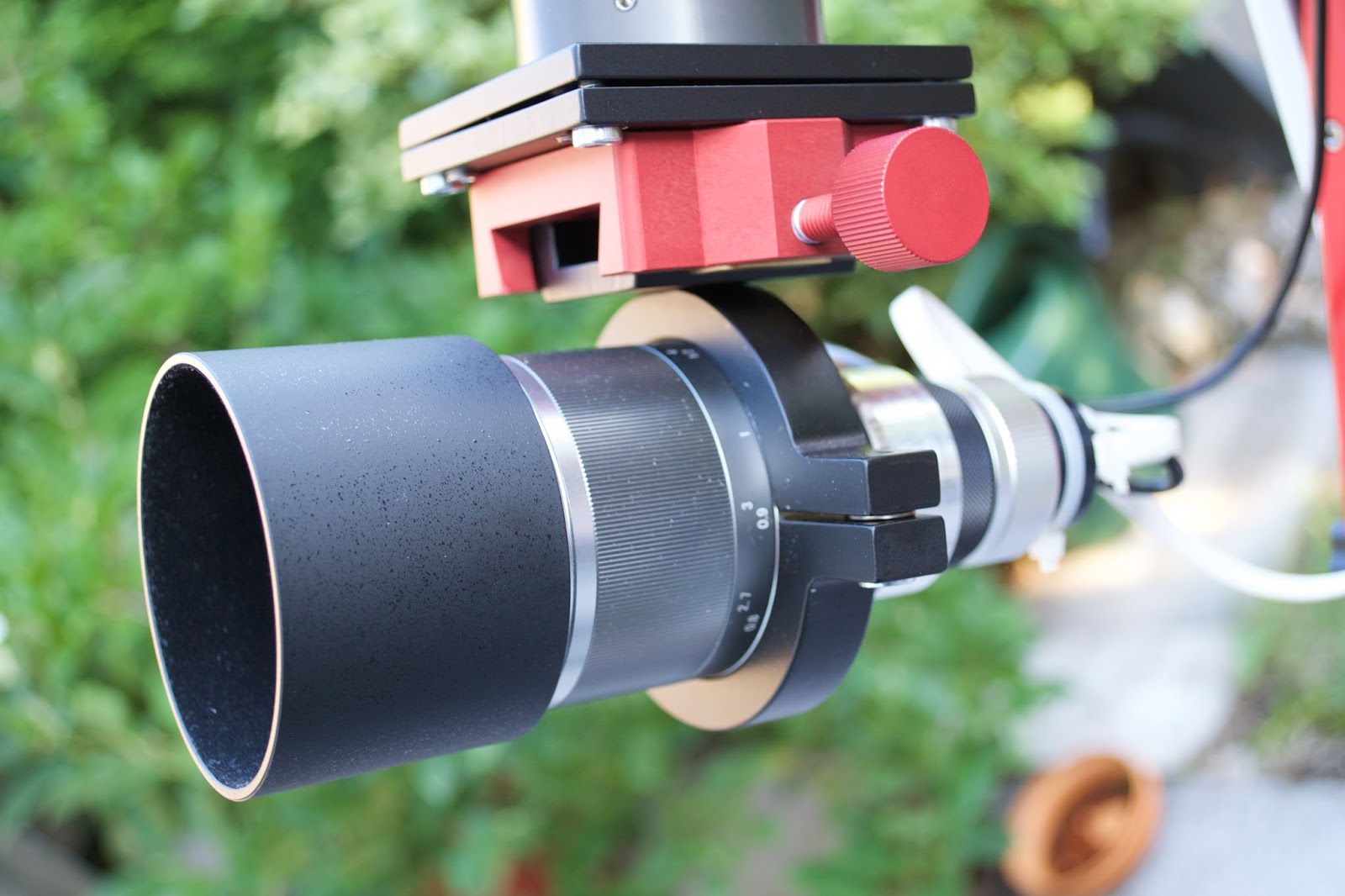
Our guider is truly unconventional. It consists of:
Tokina 300mm f/6.3 micro four third lens acting as a guider scope. Its metal back distance is 20mm.
Baader heavy duty T2 quick release is mounted on the Tokina lens sticked with two-component adhesive.
Quick-release adapter: Zeiss Micro Bajonet male to T2 male.
Takahashi eyepiece adapter taken from our Takahashi FSQ telescope. It works like the Baader-Click-Lock for 1.25" to flexibly snap the Lodestar (allowing to focus the Lodestar). It provides a T2 to 1.25" adaption.
Starlight Lodestar guiding camera, residing deep inside the ClickLock to come in focus.
The software MaximDL or PHD Guiding are used to control it.
The best light beams come through
Filters
Baader 36mm filter set for Full-Frame-CCD, consisting of three filters - H-alpha 7nm , OIII 8,5nm , SII 8nm. The filters are round, 2mm thick, without cell.
Baader RGB color filter set: 2mm thick, new 2015 version with steeper slope to better absorb the light pollution.
The following filters which are also 2mm thick are used: Red filter , Green filter , Blue filter
Possible filter variants could also be: Baader Highspeed Filter. Unfortunately, these are not available in 36mm size for the slim (10mm thick) filter drawer we have used.
We avoided no name filters. At diaphragm f/2, issues like halos around the stars or reflections can occur if the filter layers are not plane-parallel ground processed.
The right place for the right things
Filter Drawer
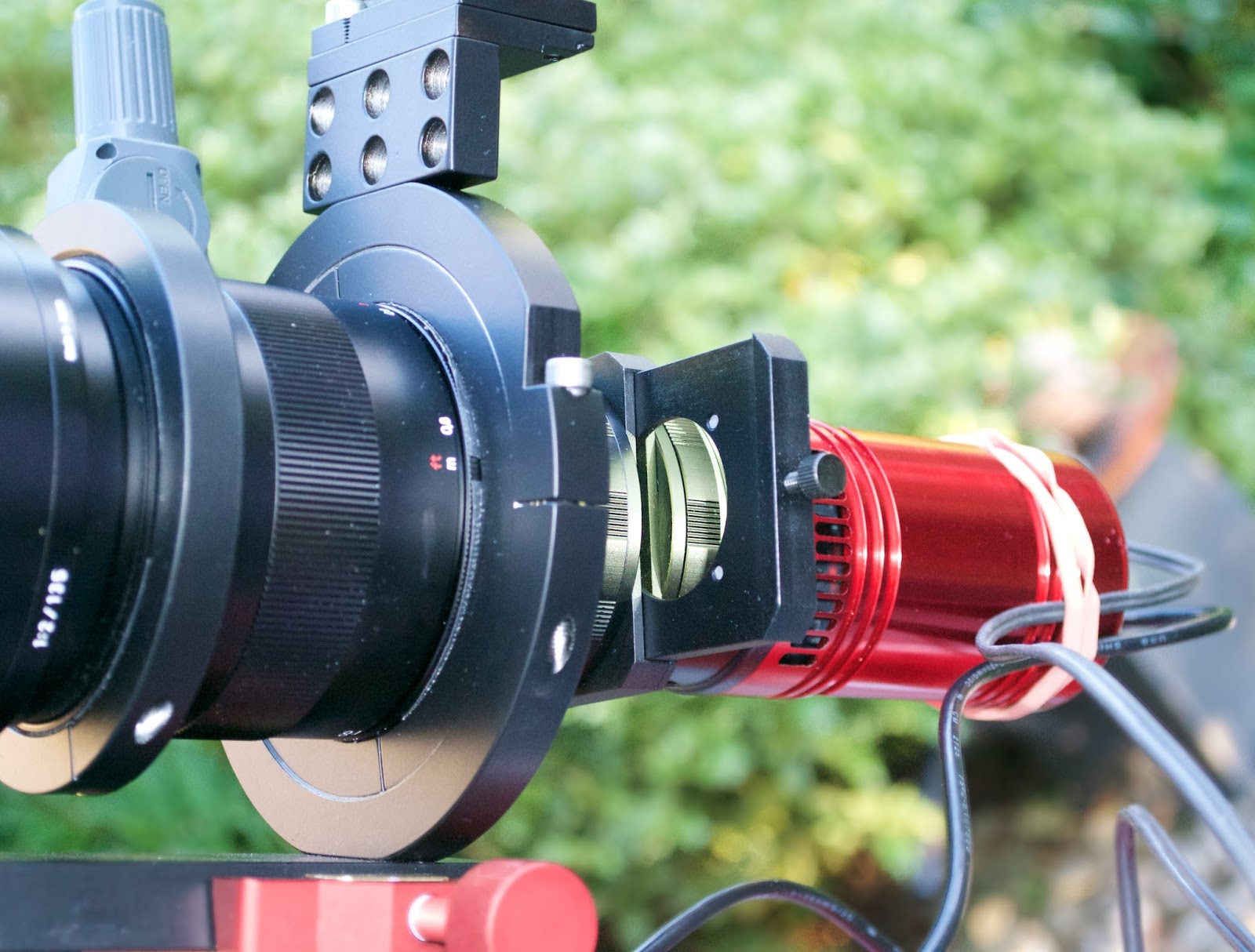
Filters are usually hosted in dust-tight filter wheels which are mostly big, thick and heavy. The short flange focal distance of the Nikon F-mount specification and our main objective to keep down the total system weight limited our options. A thin, light filter drawer was the best choice!
Our filter drawer is only 10mm thin. Other sizes with a thickness of more than 15 mm are unsuitable. The Zeiss lens is connected to the filter drawer via a Canon-M48 Adapter. The filter drawer is connected to the CCD via an adapter and 3mm long T2-extension tube.
Smart is beautyful
Mount
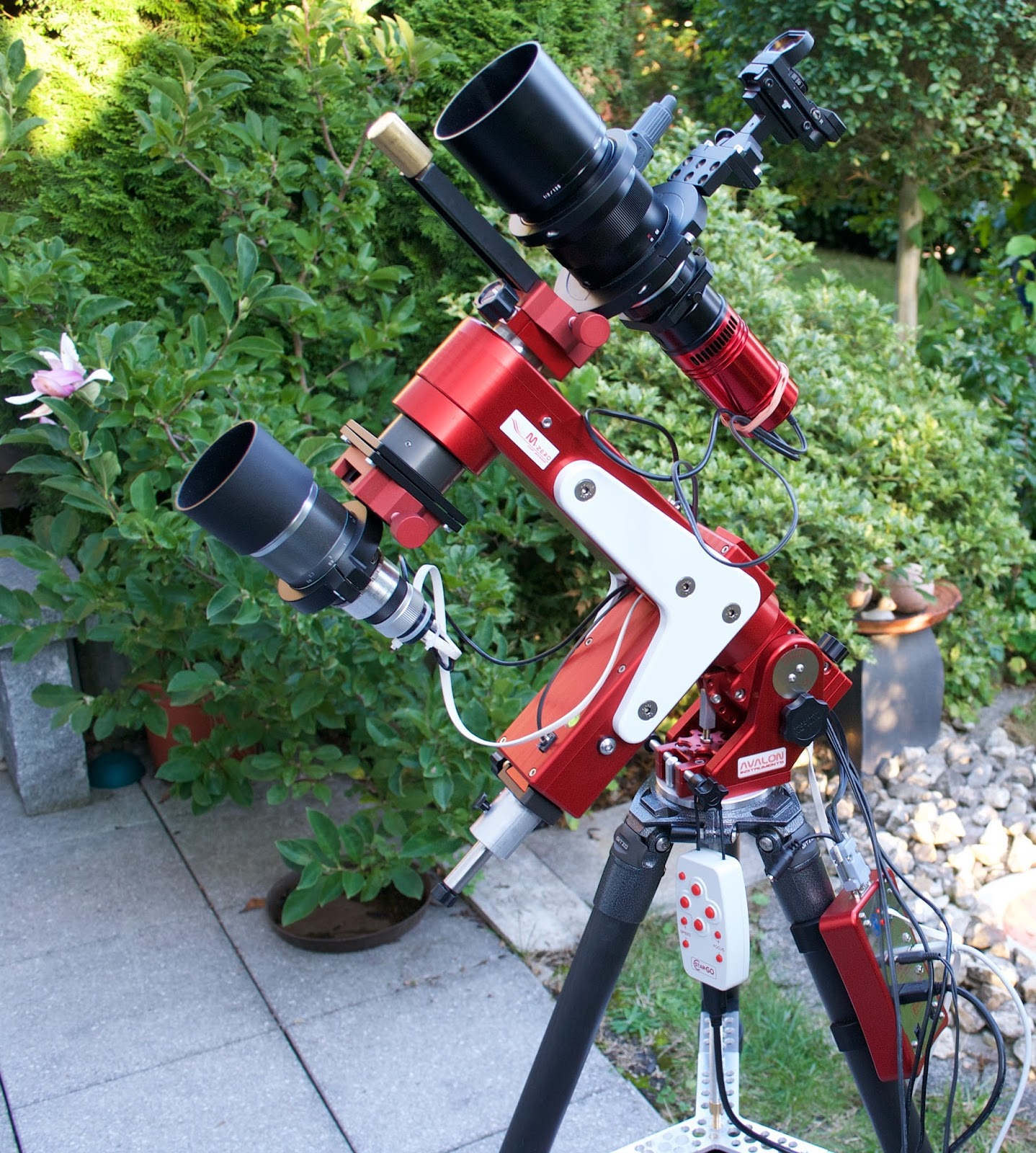
Only few American, Japanese and European companies are nowadays able to produce a good telescope mount. In the 8kg load class the alternatives are even more limited. One of the most suitable mounts for our system is the Italian Avalon M-Zero.
This is why we have chosen it:
low weight, high quality mount
GoTo controller
no worm backslash, because there are no worms.
no counter weights required, due to its smart design.
stable working software.
mount controllable via PC or smartphone.
no meridian tilt required during exposures.
made in the European Union.
We have used some adaptions to customize our setup:
Avalon Guiding adapter is on the other axis side of the telescope so that you can install a Guider there. A smart feature of the Avalon mount that saves passive counterweight.
Two tiltable adjustment plates made by astroholgi.de (see photo) on the Guiding Adapter.
Dove Tail Clamp Adaption on the adjustment plate (similar to Avalon GP clamp).
Astroholgi Star Plate (see photo) to strengthen the tripod.
The Rock
Tripod
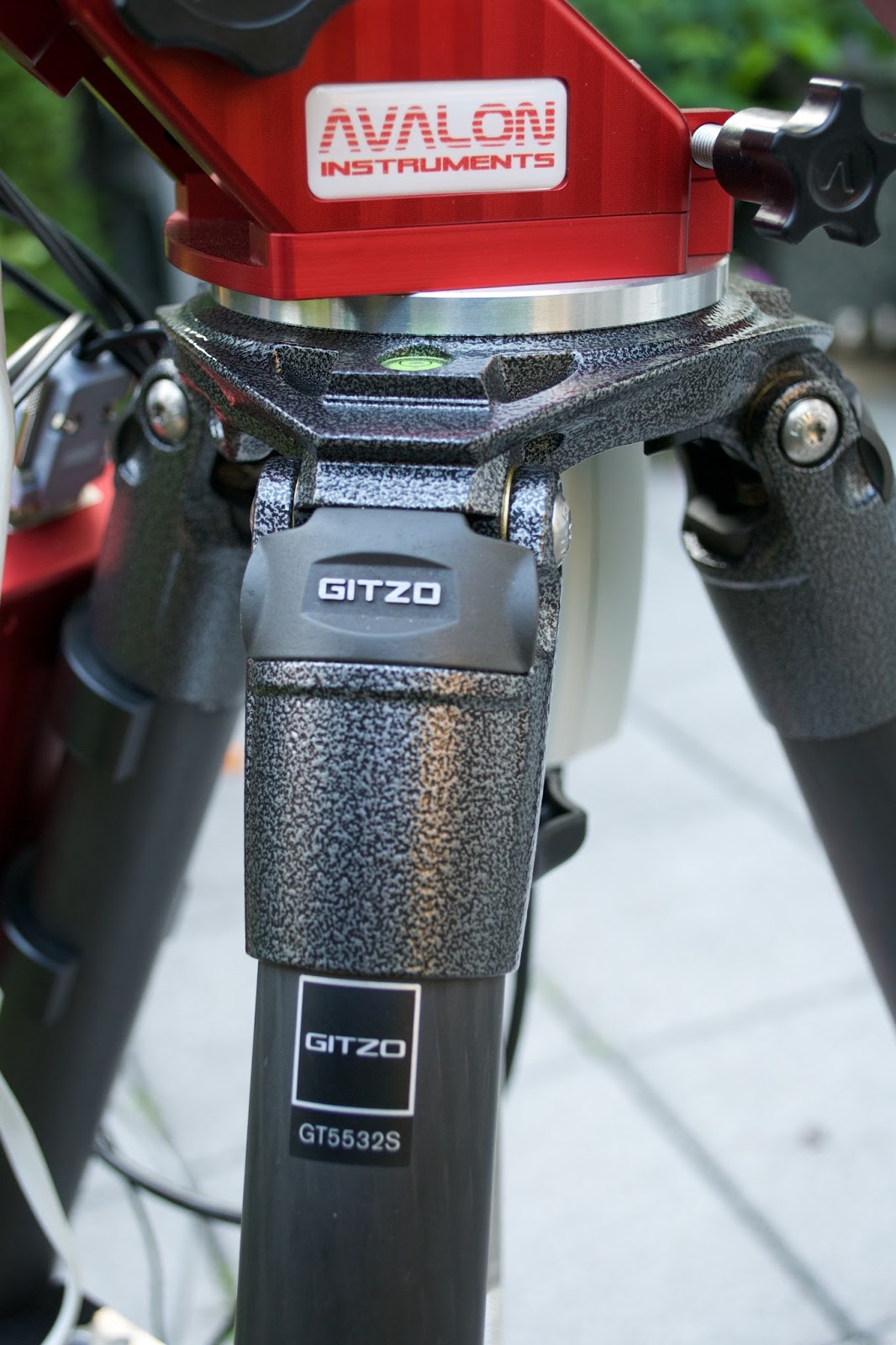
The Gitzo Systematic GT5532s is a modular tripod, with a flat centre disk that can be interchanged for centre columns, levelling bases and other components. A good example for that, is the adapter connecting the Gitzo tripod with the Avalon mount. See Astroholgi's Tripod to Mount adapter.
The Gitzo tripod has leg angle settings but they are not needed in our case. Its strong leg tubes are in 6X carbon fibre with Gitzo's efficient G-locks. Having a weight of only 2.8kg the Gitzo GT5532s can safely carry 40kg of astronomy equipment. Its reputation as "The Rock" is confirmed every time we use it.
The Gitzo reaches a max. height of 132.5 cm with its 3-section legs fully extended, which is enough for our application. There is also a longer 4-section model in Gitzo's product catalog but we suppose the 3-section version should be more stable than the 4-section one. Anyway, both of them are officially specified for a 40kg load capacity, which are good news.
Power up!
Computer and Batteries
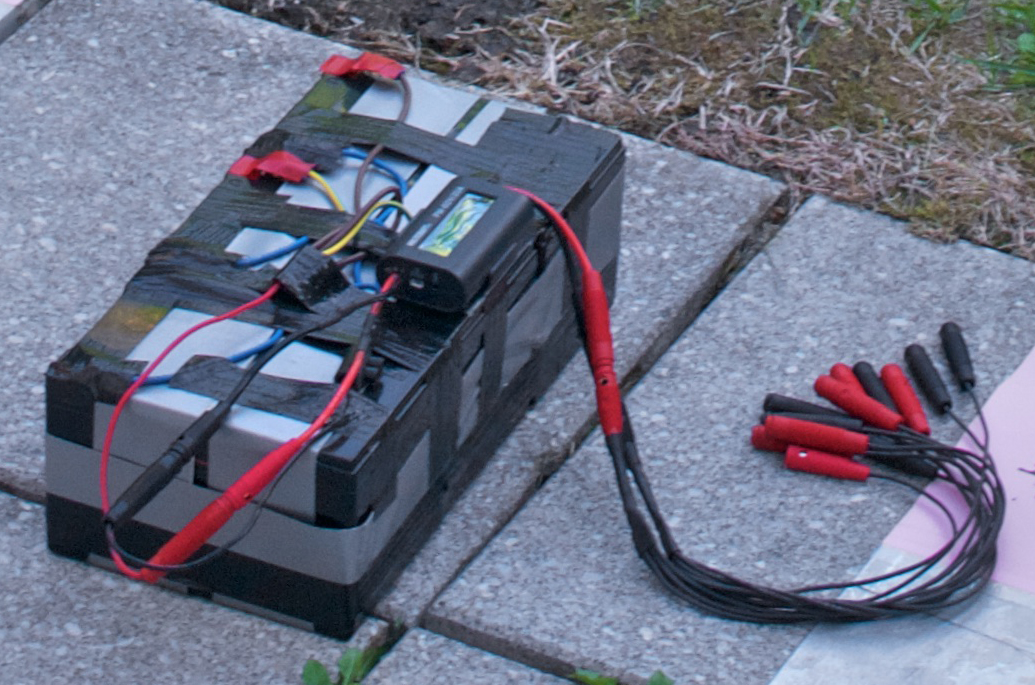
The supplied Avalon software runs on a Windows laptop. Additionally, an Android app to control the mount via smartphone is also supplied. MaximDL Pro is used to control the CCD camera and the Guider.
Three lithium iron phosphate rechargeable batteries are connected in parallel. See LiFeEnergy LiFePO4 Accu 12V/12Ah with BMS.
They offer sufficient energy for one night.
Space photos!
Gallery and Software
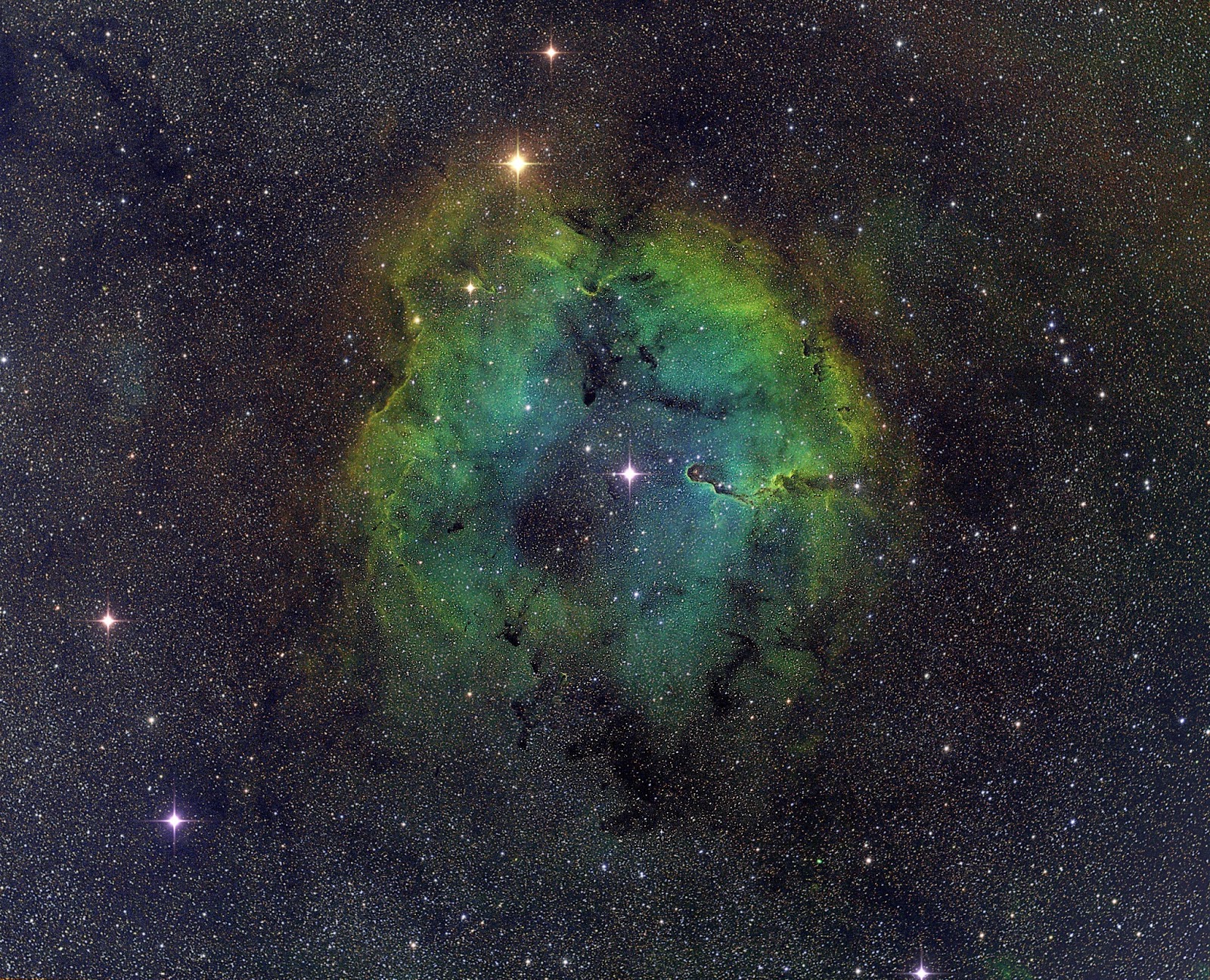
A narrowband image of IC1396 with our setup
This setup is shown in gallery #1, gallery #2, video.
Astronomy photos with the setup are: North America Nebula, The Cirrus Complex, IC1396.
All telescope computations are done with my AstroDigital.Net software. The very first prototype of Astroholgi's MicroFocuser is shown here.
Conclusion
This setup addresses ambitious astrophotographers needing a high performance, portable system for narrowband work. Our ten thousand dollar baby embodies a sophisticated concept, high-grade mechanics, first-class optics and modern electronics. Its low power consumption and its adequate weight make it suitable for field use. Its resolution matches the common seeing conditions in most northern countries where useful nights are rare.
Thanks for reading
Panagiotis Xipteras
(Original review at the author website: https://com.xipteras.org/Astronomy/Equipment-Reviews/F2-Narrowband-Machine)










